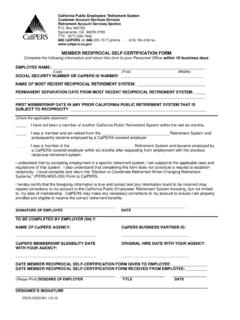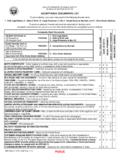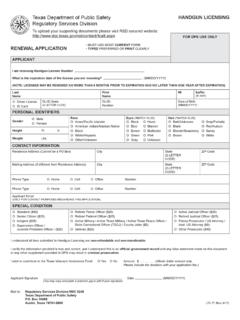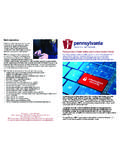Transcription of Overview of AB 109/SB 85 (Public Safety Realignment)
1 Fact sheet For Informational Purposes (916) 445-4950. December 19, 2013. 2011 public Safety realignment The cornerstone of California's solution to reduce prison overcrowding, costs, and recidivism In 2011, Governor Edmund G. Brown Jr. signed Assembly Bill (AB) 109 and AB 117, historic legislation to enable California to close the revolving door of low-level inmates cycling in and out of state prisons. It is the cornerstone of California's solution to the Supreme Court order to reduce the number of inmates in the state's 33 prisons to percent of original design capacity. All provisions of Assembly Bill (AB) 109 and AB 117 were prospective and implementation of the 2011 realignment Legislation began October 1, 2011. No inmates currently in state prison were or are transferred to county jails or released early. Prior to realignment , more than 60,000 felon parole violators returned to state prison annually, with an average length of stay of 90 days.
2 On September 30, 2011, the felon parole violator population was 13,285; by the end of November 2013, that population was down to 25 due to the fact that most felon parole violators now serve revocation time in county jail. Under realignment , newly-convicted low-level offenders without current or prior serious or violent offenses stay in county jail to serve their sentence; this has reduced the annual admissions to less than 36,000 a year. Prior to realignment , there were approximately 55,000. to 65,000 new admissions from county courts to state prison. Overall, the diversion of low-level offenders and parole violators to county jail instead of state prison since October 2011 has resulted in a population decrease of about 25,000. Funding of realignment AB 109 provides a dedicated and permanent revenue stream to the counties through Vehicle License Fees and a portion of the State sales tax outlined in trailer bills AB 118 and Senate Bill 89.
3 The latter provides revenue to counties for local public Safety programs and the former establishes the Local Revenue Fund 2011 (Fund) for counties to receive the revenues and appropriate funding for 2011 public Safety realignment . This funding became constitutionally guaranteed by California voters under the passage of Proposition 30 in 2012. $400 million was provided to the counties in the first partial fiscal year of realignment , growing to more than $850 million last year and more than $1 billion in 2013-2014. The following trailer bills were signed to secure sufficient funding for counties: AB 111. o Gives counties additional flexibility to access funding to increase local jail capacity for the purpose of implementing realignment . CDCR Fact Sheet Page 1. AB 94 (2011 realignment Legislation Addressing public Safety ). o Came into effect upon the passage of AB 111.
4 O Authorizes counties that have received a conditional award under a specified jail facilities financing program to relinquish that award and reapply for a conditional award under a separate financing program. o Lowers the county's required contribution from 25 percent to 10 percent and additionally requires CDCR and the Corrections Standard Authority to give funding preference to those counties that relinquish local jail construction conditional awards and agree to continue to assist the state in siting re-entry facilities. AB 118. o Outlines the financial structure for allocating funds to a variety of accounts for realignment . o Establishes the Local Revenue Fund 2011 for receiving revenue and appropriates from that account to the counties. o Directs the deposit of revenues associated with percent of the state sales tax rate to be deposited in the Fund.
5 O Establishes a reserve account should revenues come in higher than anticipated. o The reallocation formulas will be developed more permanently using appropriate data and information for the 2012-13 fiscal year and each fiscal year thereafter. o Implements sufficient protections to provide ongoing funding and mandated protection for the state and local government. o The smallest of counties that benefitted from the minimum grant each received approximately $77,000 in 2011-12. SB 89. o Dedicates a portion ($12) of the Vehicle License Fee to the Fund. o Revenue comes from two sources: freed up VLF previously dedicated to DMV. administration and VLF that was previously dedicated to cities for general purpose use. o Estimated total amount of VLF revenue dedicated to realignment was $ million in 2011-2012. SB 87. o Provided counties with a one-time appropriation of $25 million to cover costs associated with hiring, retention, training, data improvements, contracting costs, and capacity planning pursuant to each county's AB 109 implementation plan.
6 Local Planning Process The Community Corrections Partnership (CCP), which was previously established in Penal Code 1230, developed an implementation plan for their respective county. The Executive Committee from the CCP members is comprised of the following: o Chief probation officer o Chief of police o Sheriff o District Attorney o public Defender o Presiding judge of the superior court (or his/her designee). o A representative from either the County Department of Social Services, Mental Health, or Alcohol and Substance Abuse Programs, as appointed by the County Board of Supervisors. CDCR Fact Sheet Page 2. Community, Local Custody AB 109 allows non-violent, non-serious, and non-sex offenders to serve their sentence in county jails instead of state prisons. However, counties can contract back with the State to house local offenders.
7 Under AB 109: No inmates are transferred from state prisons to county jails. No state prison inmates are released early. All felons sent to state prison prior to the implementation of realignment will continue to serve their entire sentence in state prison. All felons convicted of current or prior serious or violent offenses, sex offenses, and sex offenses against children will go to state prison. There are nearly 70 additional crimes that are not defined in the Penal Code as serious or violent offenses but at the request of law enforcement and district attorneys were added as offenses that would be served in state prison rather than in local custody. Post-Release (County-Level) Community Supervision CDCR continues to have jurisdiction over all offenders who were on state parole prior to the implementation date of October 1, 2011.
8 County-level supervision for offenders upon release from prison includes current non-violent, current non-serious (irrespective of priors), and some sex offenders. County-level supervision does not include: Inmates paroled from life terms to include third-strike offenders;. Offenders whose current commitment offense is violent or serious, as defined by California's Penal Code (c) and (c);. High-risk sex offenders, as defined by CDCR;. Mentally Disordered Offenders; nor Offenders on parole prior to October 1, 2011. Offenders who meet the above-stated conditions continue to be under state parole supervision. In all 58 counties, the Probation Department is the designated agency responsible for post- release supervision. CDCR must notify counties of an individual's release at least one month prior, if possible. Once the individual has been released, CDCR no longer has jurisdiction over any person who is under post-release community supervision.
9 Currently, CDCR is working to ensure counties receive inmate packets 120 days prior to the ordered release date. No person shall be returned to prison on a parole revocation except for those life-term offenders who paroled pursuant to Penal Code (Penal Code 3056 states that only these offenders may be returned to state prison). Parole Revocations As of October 1, 2011, all parole revocations are served in county jail instead of state prison and can only be up to 180 days. As of July 1, 2013 the parole revocation process is now a local court-based process. Local courts, rather than the Board of Parole Hearings, are the designated authority for determining parole revocations. CDCR Fact Sheet Page 3. Contracting back to the state for offenders to complete a custody parole revocation is not an option. Only offenders previously sentenced to a life term can be revoked to prison.
10 The Board of Parole Hearings continues to conduct: Parole consideration for lifers;. Medical parole hearings;. Mentally disordered offender cases; and Sexually Violent Predator cases. AB 109 also provides the following under parole: Allows local parole revocations up to 180 days Authorizes flash incarceration at the local level for up to 10 days Inmates released to parole after serving a life-term ( , murderers, violent sex offenders, and third-strikers) will be eligible for parole revocation back to state prison if ordered by the Board. Effects on Conservation Camps Conservation camps are currently at capacity CDCR is currently working with CAL FIRE and the counties to use county inmates to help fill the vacancies. Effects on Female Population As a substantial portion of female offenders fall under the definition of non-serious, non-violent, and non sex-offenders, the female inmate population at CDCR has dropped by a third, approximately 3,100 inmates.

















